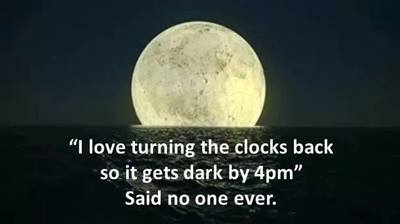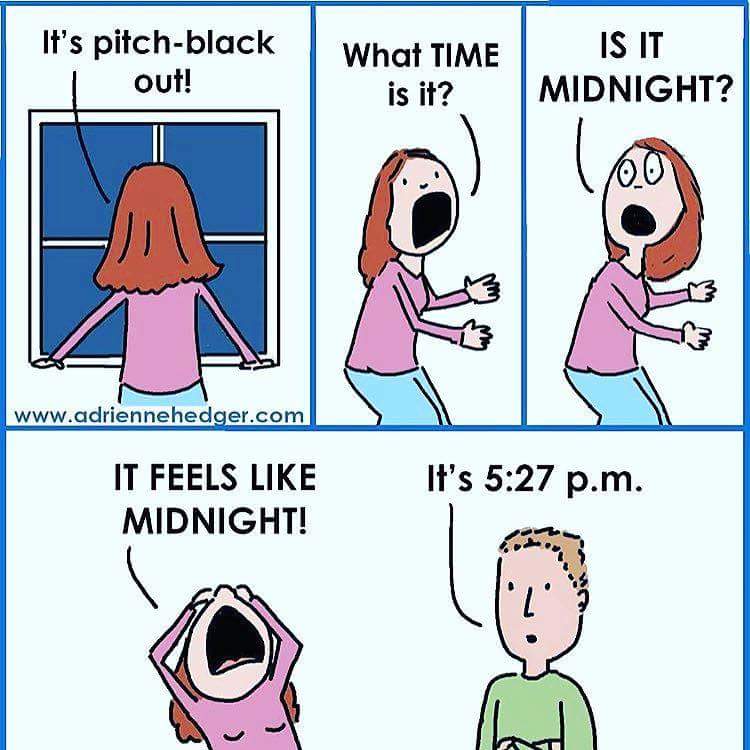If you know me — even a little — you’ve heard me fuss about changing the clocks. I hate, hate, hate it when we turn the clocks back. I’m terribly sensitive to light and require a great deal of it. (What a great thing it is that I ended up in Southern California!)
Upon retirement, I discovered that I have no bucket list. I have, however, repeatedly pledged to work to stop the clocks from moving back in the fall. It’s really the only thing I ever said I’d do when I retired. I’ve said it for years. When I retire, I’m gonna work to keep us on Daylight Saving Time year-round. Not getting rid of it, as was contemplated in the California Legislature last session.
I want to keep it light, longer. All the time. Year-round.
Daylight Saving Time: Keep it year round ~

People forget that they ever knew how to drive. Traffic and work-related accidents increase. On the Monday after we turn the clocks back, doctors and emergency rooms watch for up to 25% more heart attacks. One study estimated lost productivity at $434 million annually. A 2008 U.S. Department of Energy report shows the change results in energy costs higher than staying “an hour ahead.” Reports and studies cite potentially detrimental long-term effects: disruption in the quality of sleep, biological and circadian rhythm disruptions, memory loss and confusion.
What daylight saving time does to your body
It makes me sad and a little anxious (more than usual!).
My seasonal sadness improved dramatically once I knew it was a real thing, that I’m not alone.
Here’s a good basic Patch summary from a story aptly titled You May Not Just Be Sad, You May Have S.A.D.:
According to Medline Plus, a service of the U.S. National Library of Medicine, Seasonal Affective Disorder (S.A.D.) is a type of depression that happens during the winter when people do not get much sunlight.
Symptoms include “feelings of sadness, loneliness, altered sleeping and eating patterns, negative thoughts and feelings of guilt, lethargy and disturbed sleep patterns; overeating and developing a craving for carbohydrates and sweet foods; difficulty with concentration and memory; and social problems such as finding it difficult to be around others,” NJ.com reports.
According to a 2014 Rasmussen survey of American adults, 48% don’t think the ritual of changing the clocks twice a year “is worth it.” Nineteen percent are not sure. Thirty-three percent deemed it “worth the hassle,” down from 37% the year before and 45% in 2012.
Way back, the original reason for changing the clock twice a year was to presumably to save candles. Did Benjamin Franklin Invent Daylight Savings Time? Daylight Saving Time (not Savings) (DST) began during World War I as a conservation measure.
Until 1966 local and state governments set their own time standards. In 1966, Congress “attempted to unify time changes and set up the standard system of Daylight Saving Time.” This means that there are now only two options available for states under federal law. California could opt out and stay on standard time year-round or keep springing forward and falling back like we do now. Staying on Daylight Saving Time year-round is not an option, absent an act of Congress. Literally. An act of Congress. Damn.
But I’m retired and this is the only thing on my non-existent bucket list (besides ending gun violence, homelessness, adult illiteracy, yoga, the grandbaby, the garden) so I’m going to try.

The Mercury News, Daylight Saving Time is here to stay in California, reports on July 5, 2017: “Last year, the California Legislature passed a bipartisan resolution asking Congress to approve a third option for states — permanent daylight saving time. South Bay Congressman Ro Khanna is now spearheading that effort in Washington, D.C.”
Let’s hope so! I’ve reached out to his office. Know anyone there?
Some states have approved – or toyed with approving – measures that suggest that if a majority of other states act to keep time from changing that they will go along. Folks on the east coast are even considering changing time zones to address the issue. An interesting thought, except people in Massachusetts have feelings.
Last week, Finland requested that the EU abolish Daylight Saving Time and while I believe this is the opposite solution, it gives me hope:
“Despite an increasingly fragmented political landscape, this temporal topic has united the country’s politicians of all ideological orientations, from the left to the far-right. All 13 Finnish Members of European Parliament have pledged to work to abolish daylight saving time.”
Fact is, we adapt. Halfway into the first week we remember how to drive, that it’s not late; it’s just dark. For those of us especially attuned to light, there are effective strategies to deal with the darkness here and also here.
But why? Why?
Is it wrong to want to keep it light longer later?
Help me figure this one out, please.
What do we call the fight? It’s confusing. There are organizing and political efforts ongoing, and I hope to connect with that work. So, again, know anyone? No wheels reinvented here.
Lock the Clock wants Standard Time permanently. Stop the Clock appears to suggest an individual response, keeping one’s own clocks on DST while the rest of the world goes back and forth. He admits it worked for about a month. The Standard Time folks intriguingly propose to move the whole country to two non-changing time zones.
There’s an old petition from when the White House accepted citizen petitions (the good old days!) and this one Keep us on Daylight Savings Time on MoveOn that seems current, albeit modest.
Longer, later light – who’s with me? Fight for the light? Names, hashtags, slogans, strategies?
I suspect/hope everyone knows someone like me who’s really bugged by this. Get ‘em in touch.
Let’s sign and share this petition: Keep us on Daylight Savings Time
Contact me directly with organizing leads: juliejbutcher@gmail.com
 LA!
LA!